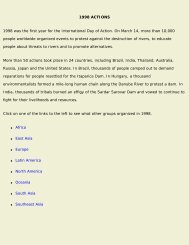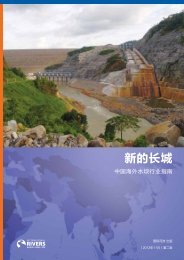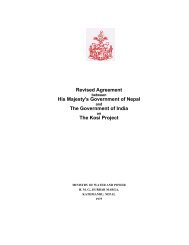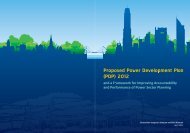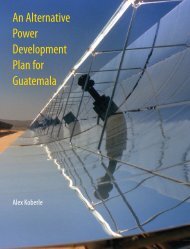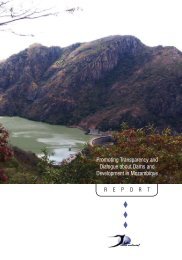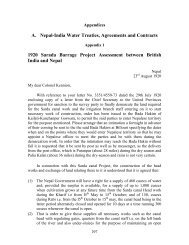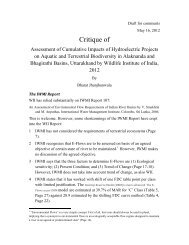Mountains of Concrete - International Rivers
Mountains of Concrete - International Rivers
Mountains of Concrete - International Rivers
You also want an ePaper? Increase the reach of your titles
YUMPU automatically turns print PDFs into web optimized ePapers that Google loves.
Former President Musharrafin his address to the nation in2006 said that “constructingtwo to three dams is inevitable”and “urgently needed” forPakistan by the year 2020 as “thedevelopment <strong>of</strong> [the] agriculturesector is the only and effectiveway to check poverty…Morewater will help us irrigate moreland along with the construction<strong>of</strong> canals and it will help increaseour agriculture production andPakistan’s economy will Inshallah prosper further…” 31While Musharraf is no longer the president, this viewis well entrenched, both with the national technocracy andthe World Bank. The World Bank’s “Pakistan Country WaterStrategy” argues strongly that there is “the urgent need forconstruction <strong>of</strong> major new storage on the Indus.” 32It is ironic that a major argument for the necessity <strong>of</strong>new big dams is that heavy sedimentation has led to the loss<strong>of</strong> storage capacity <strong>of</strong> the biggest existing dams like Tarbelaand Mangla, and so new dams are needed as replacements.This ignores the fact that the proposed new reservoirs in theHimalayas would face the same sedimentation problems, asthese rivers carry heavy silt loads.Thus, even for the largest hydropower dams like Diamer-Bhasha, agriculture continues to be the primary justification.Consider this excerpt from the former President’s websiteon the Diamer-Bhasha Dam:NEED OF THE PROJECTAgriculture is the backbone <strong>of</strong> Pakistan’s economy.Pakistan today is among one <strong>of</strong> the World’s fastestgrowing populations, now estimated at over 150million. Due to the lack <strong>of</strong> large river regulationcapability through sizeable storages, the country isalready facing serious shortages in food grains. Giventhe present trend, Pakistan could soon become one<strong>of</strong> the food deficit countries in the near future.Therefore, there is a dire need to build storages foraugmenting agriculture production. 33This is a key emotional and political driver for many <strong>of</strong>the new dams. One <strong>of</strong> the reasons why irrigation andagriculture have been the main political arguments used topromote dams could be that until 2005, Pakistan seemed tohave surplus power even during peak demand times. 34 Thesituation has now changed with rampant power cuts andpower shortages. The power deficit is predicted to grow to5,500 MW by 2010 unless new power projects are broughtonline. Furthermore, about 40% <strong>of</strong> firms in Pakistanidentified electricity as a major constraint for the operationand growth <strong>of</strong> their businesses; a quarter <strong>of</strong> the Pakistanipopulation has no access to electricity at all. 35Several observers have noted that the “reforms”in the power sector initiated at the behest <strong>of</strong> theWorld Bank and the Asian Development Bank(ADB) since the 1990s have led to a number <strong>of</strong>people losing access to electricity as tariffs haverisen sharply and subsidies have been cut back.Thus the need to meet increasing electricity demandsis also becoming an important justification for the big damplans in Pakistan.IndiaIn India, the basic driver for hydropower is the demand forelectricity.India continues to be plagued by power and energyshortages. Overall for the country, peak power demand inthe year 2007-08 was 108,886 MW, while the peak powerdemand met was 90,793 MW; there was a shortfall <strong>of</strong> 18,093MW or 16.6% <strong>of</strong> peak demand. 36 The energy demand inthe same year was 737,052 GWh, towards which energyavailability was 664,660 GWh. This was a deficit <strong>of</strong> 72,392GWh, or 9.8%.A large portion <strong>of</strong> Indian society does not have accessto electricity. According to the Working Group on Powerfor the 11 th Five Year Plan, 154,567 villages, or a full 26% <strong>of</strong>the inhabited villages in the country, were without access toelectricity in 2006. 37 The household-level picture is worse;according to the 2001 Census, 44.2% <strong>of</strong> households in Indiadid not have access to electricity. 38Shortages affecting urban centres are also leading todemonstrations, violence and riots in some parts <strong>of</strong> thecountry. At the same time, vulnerable sections <strong>of</strong> society,like the poor, and small and marginal farmers, are findingaccess to electricity more and more difficult due to a lack <strong>of</strong>physical access or increasing tariffs.The government <strong>of</strong> India also argues for an increase inpower generation capacity in order to meet some declaredsocial objectives. These, as articulated in the NationalElectricity Policy <strong>of</strong> February 2005, include:n Access to Electricity – Available for all households in thenext five years;n Availability <strong>of</strong> Power – Demand to be fully met by 2012with energy and peaking shortages to be overcome (the“Power on Demand” policy);n Per capita availability <strong>of</strong> electricity to be increased toover 1,000 units (1,000 KWh) by 2012;n Minimum lifeline consumption <strong>of</strong> 1 unit (1 KWh)/household/day by the year 2012. 39<strong>Mountains</strong> <strong>of</strong> <strong>Concrete</strong>: Dam Building in the Himalayas | 9




